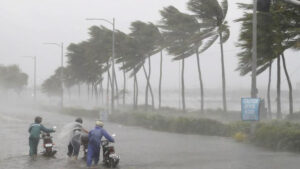Physical Address
23,24,25 & 26, 2nd Floor, Software Technology Park India, Opp: Garware Stadium,MIDC, Chikalthana, Aurangabad, Maharashtra – 431001 India
Physical Address
23,24,25 & 26, 2nd Floor, Software Technology Park India, Opp: Garware Stadium,MIDC, Chikalthana, Aurangabad, Maharashtra – 431001 India

India recorded extreme weather events on 241 of the 273 days from January to September in 2022. The data is evidence that about 90 percent of the first nine months of this year had extreme weather events in one or more parts of the country, the Centre for Science and Environment (CSE) said in its new report. CSE bases this claim on an analysis of data from the Indian Meteorological Department and the Ministry of Home Affairs Disaster Management Division.
The report also tries to highlight estimates for ‘loss and damage’ as a result of these extreme weather events which is at best ‘conservative’ according to the researchers of the study. This is a ‘significant finding’ at a time when world leaders are meeting for the UN Climate Summit at COP27 in Egypt and ‘loss and damage’ has been formally inducted into the agenda of the COP27.
The 7 Extreme Weather Events faced by India (Jan-Sept 2022)
Lightning and Storms: On 159 of 273 days, India experienced lightning and storms. They claimed 954 lives. Assam and Bihar were the most affected.
Heavy rains, floods and landslides: On 157 of 273 days, India experienced heavy rains, floods or landslides. They claimed 1,214 lives. Assam was most affected.
Heatwaves: On 66 of 273 days, India experienced heatwaves. They were spread across 20 states/UTs and claimed 45 lives. The Central and western states were most affected.
Cold waves/cold days: On 30 of 273 days, India experienced a cold wave/cold day. They were spread across 14 states/UTs. Uttar Pradesh and Madhya Pradesh were the most affected.
Snowfall: On 2 of 273 days, India experienced snowfall. They were spread across 2 states/UTs and claimed 8 lives. Jammu Kashmir and Arunachal Pradesh were the most affected.
Cloudbursts: On 11 of 273 days, India experienced cloudbursts. They claimed 33 lives across four states/UTs. The Himalayan states of the Northwest were the most affected by these.
Cyclones: On 2 of 273 days, India experienced cyclones. They claimed three lives in Andhra Pradesh.
The Consequences – Loss and Damage
The data showed that India is suffering severe loss and damage due to the climate crisis. The extreme weather events during this period claimed 2,755 lives and affected 1.8 million hectares of the crop area. The analysis also found that it destroyed about 416,667 houses and killed 69,007 livestock.
In 2022, India recorded its seventh wettest January since 1901, according to weather office data. March was the warmest ever and the third driest in 121 years. Eastern and northeast India saw its warmest and driest July in 121 years. The region also recorded its second-warmest August and 4th warmest September this year.
The magnitude of impact is different in different regions:
| Regions | No. of Days out of 273 | Lives Lost | Damaged crop area (in hectares) | Animals killed |
| Central India | 198 | 887 | 136,780 | 28,032 |
| Northwest India | 195 | 735 | 393,726 | 1707 |
| East and Northeast India | 171 | 783 | 256,517 | 55,399 |
| South India | 125 | 350 | 1,060,000 | 4382 |
The loss of lives due to extreme weather events in different regions of India.
What the Experts say
“This is the watermark of climate change. It is not about any single event but about the overall increased frequency of the events. An extreme event earlier we saw once every 100 years, now occurs every five years or less,” the CSE report said.
Sunita Narain, director general of CSE said, “We need to get a full picture of extreme weather events. More than the disasters, we need to count the losses and damages. We need to put a human face on the impacts of climate change so that we can invest in risk and resilience. We must demand reparations for loss and damage from countries responsible for historical emissions in the atmosphere,” Narain said.
“There is a definite rising trend in extreme and very heavy rainfall events during monsoon months. It has not been quantified but the rising trend has been documented,” Dr. Mrutyunjay Mohapatra, Director General of Meteorology, said in response to CSE’s findings.
(with inputs from Aayushi Sharma)